Solayer USD (sUSD) - The First Yield-bearing Stablecoin on Solana
 Elizabeth Bassey
Elizabeth Bassey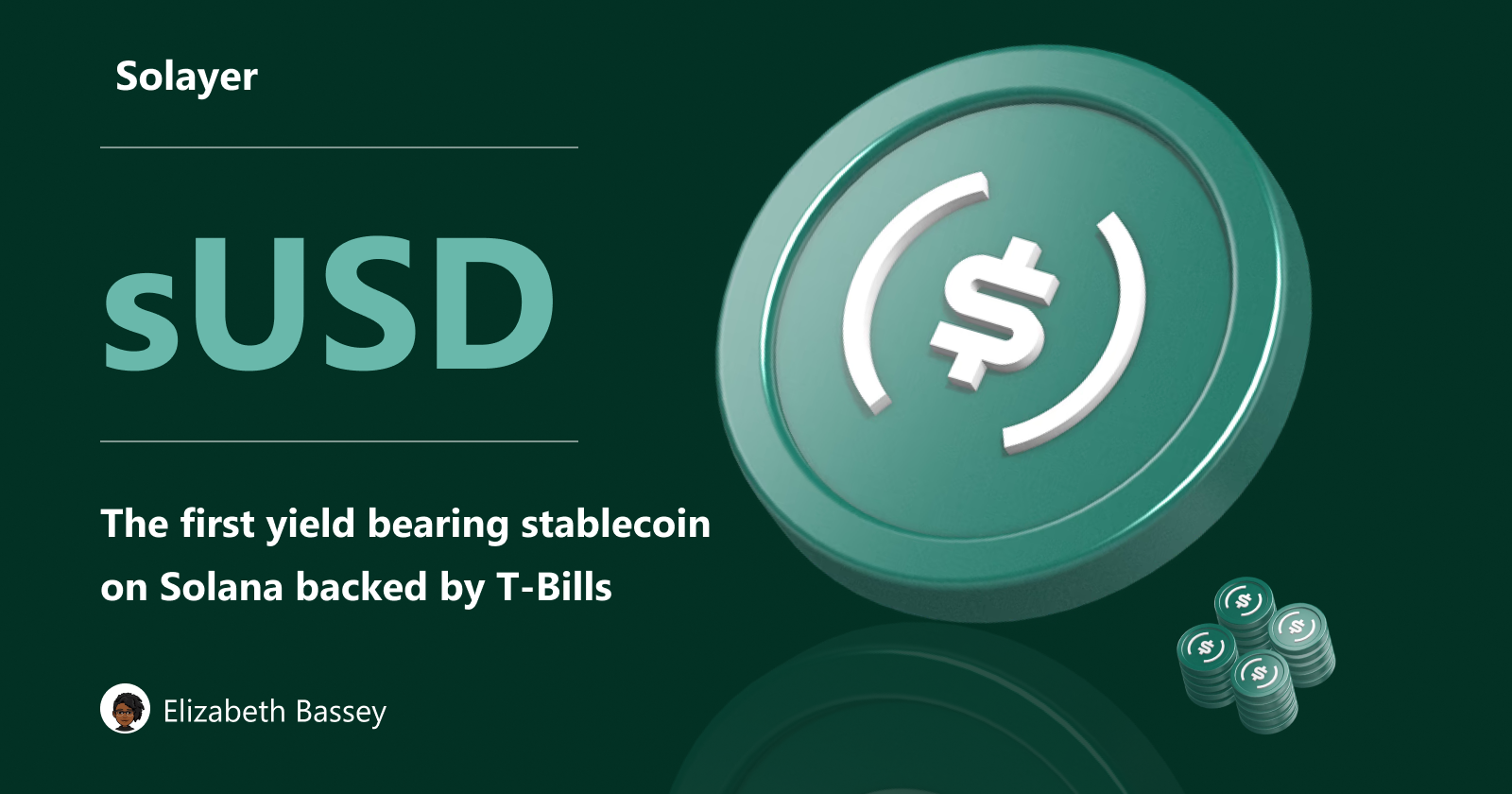
Introduction
In the evolving world of cryptocurrency, stablecoins such as USDC and Tether - designed to maintain a consistent value through a peg to another asset such as the US Dollar, have become essential in bridging the gap between crypto and fiat, providing stability, liquidity, and ease of use across various applications. However, these traditional stablecoins, have not always lived up to their promised stability. They have on several occasions fallen below the prices of their pegged assets, and have faced challenges of centralized control, inconsistent transparency, and regulatory risks.
sUSD, a revolutionary yield-bearing stablecoin, has been designed to address these challenges. It is backed by real-world, less-volatile assets, such as the US Treasury Bill, and utilizes an on-chain protocol, bringing a blend of decentralization and traditional finance, to ensure trust, transparency, and predictable yield. In this article, we will explore the major problems of traditional stablecoins, and how sUSD provides an accessible and secure alternative that could reshape the stablecoin landscape.
Problems of Traditional Stablecoins
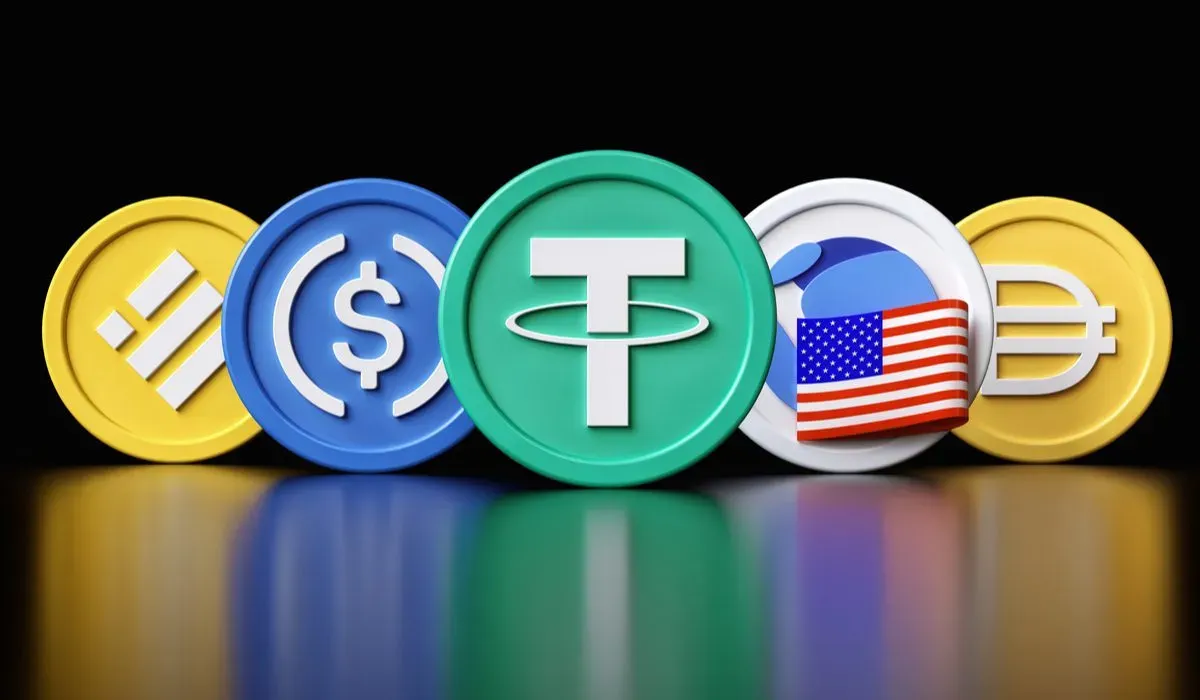
Driven by market events, traditional stablecoins have met several concerns regarding their stability, transparency, and regulations and have at some occasions lost their pegs to reference assets. One of such events was documented in:
Tether USDT S&P Rating:
According to Investopedia crypto news in 2023, S&P Global Ratings (a division of S&P Global that publishes financial research and analysis on stocks, bonds, and commodities), released an assessment of Tether USDT stablecoin, which concluded that the digital currency’s ability to maintain its peg is “constrained”. This was so because S&P Global Rating had some concerns about Tether’s reserve transparency and regulatory framework
In the news, the rating agency gave an asset assessment score of 4 out of 5, stating the assessment to reflect a lack of information on entities that are custodians, counterparties, or bank account providers of the assets.
The report also pointed to the lack of a regulatory framework and asset segregation as other shortcomings of the Tether USDT.
This report proved that the Tether USDT was controlled by a centralized entity and was also not transparent in its operations which was enough to raise concerns.
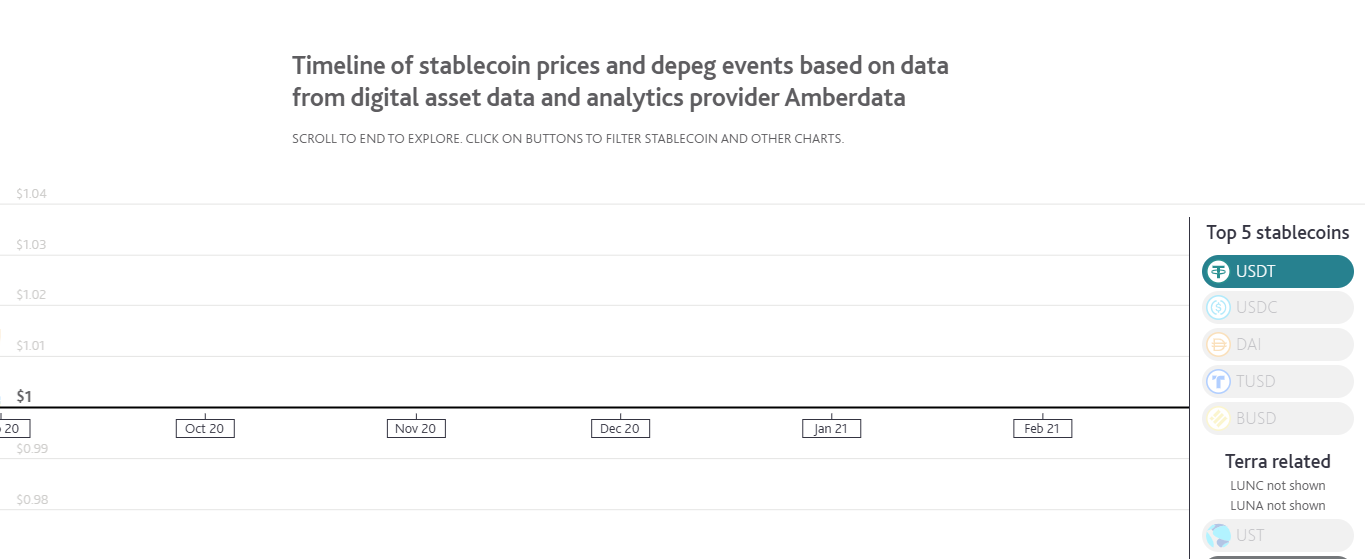
Timeline of stablecoin prices and depeg events on moodys
Other such events that proved the non-stability and lack of transparency of traditional stablecoin (according to Moodys.com) include:
Terra’s Stablecoin Collapse (May 2022)
This highlighted risks associated with unregulated stablecoins
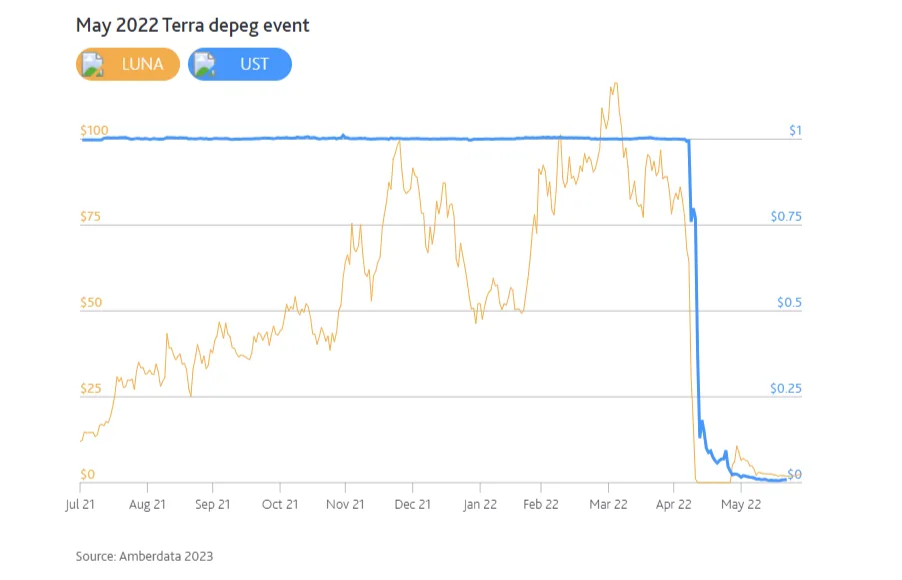
USDC Depeg (March 2023)
This event highlighted how stress within traditional finance, led to the loss of USDC’s peg.
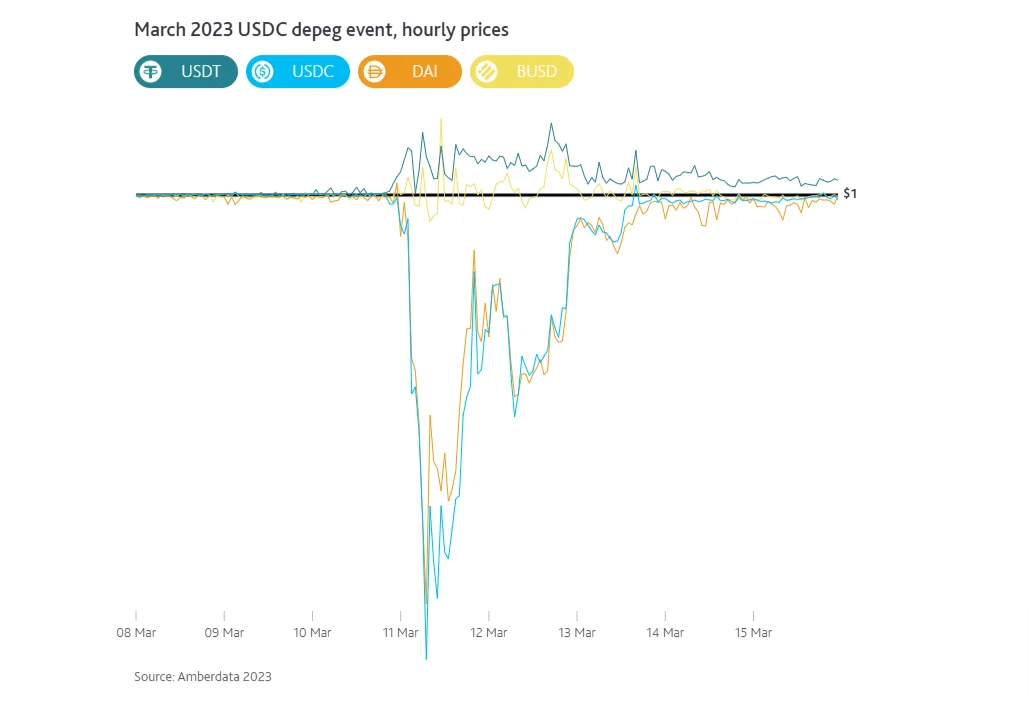
All of these events highlighted the challenges of traditional stablecoins, such as centralization and lack of transparency, which had severe impact on Defi and the entire crypto market.
Introducing sUSD
sUSD is the first yield-bearing restaking stablecoin on Solana, designed by Solayer (Solana Restaking Network), to offer a steady 4-5% yield through T-bill investments and to secure external systems, known as Actively Validated Services (AVSs).
Unlike, Traditional stables which are only pegged with fiats, sUSD is pegged to the U.S. dollar and backed by the U.S. Treasury Bills (T-bills), this ensures that sUSD maintains a 1:1 peg (i.e a stable $1 worth) with the U.S. dollar while also being able to generate a 4 -5% yield, through the T-Bill asset that backs the stablecoin.
How it works
Unlike traditional stablecoins which are built on centralized entities, sUSD utilizes a Request-for-quote (RFQ), non-custodial protocol built on the Solana Blockchain.
This simplifies the yield-earning process for users and ensures that operations and transactions on the protocol are decentralized and transparent.
To earn yields on the sUSD pool, users simply have to lock in their USDC (as low as $5) on the RFQ protocol to create a quote using the dashboard interface.
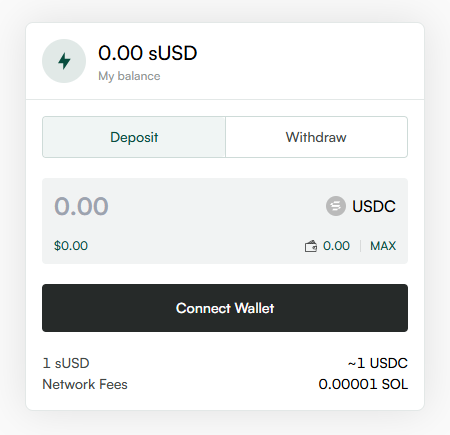
Once the USDC is locked into the platform, the user becomes a liquidity provider, their fund is used to purchase a tokenized T-Bill known as Wrapped T-bill, which is then used to mint the sUSD token, and the sUSD token is then forwarded to the User. The user might decide to delegate this token to Exogenous AVSs (Actively Validated Services) to help provide economic security to these systems.
If the user wishes to withdraw their USDC, all they need to do is send back the sUSD token to initiate the withdrawal process. And their USDC will be returned back to them with accumulated yields based on the calculated rate and duration.
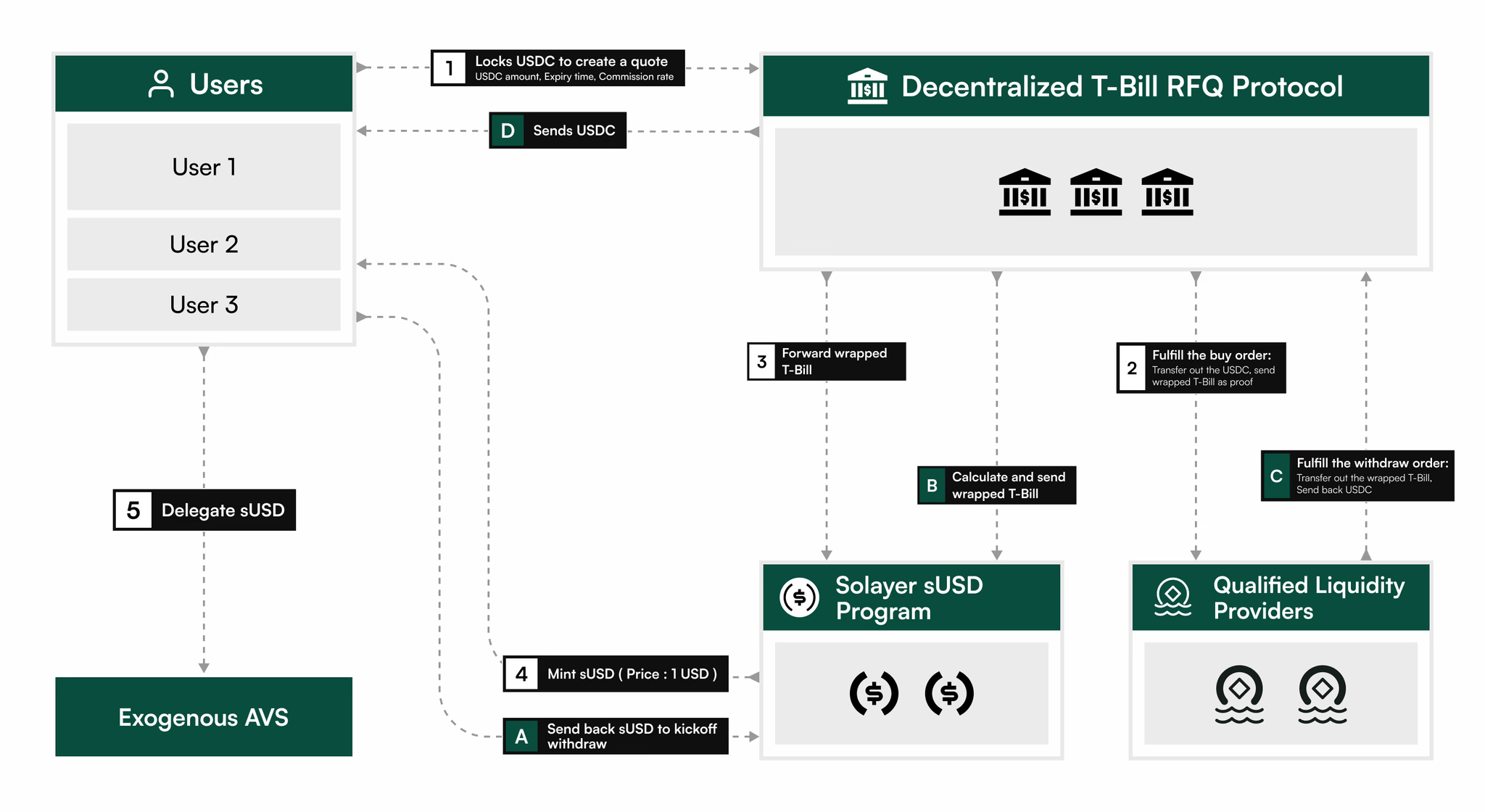
A detailed flow of the sUSD RFQ protocol
What makes sUSD stand out?
Backed by RWA (real-world assets) and designed for both stability and growth, sUSD combines DeFi innovation with institutional reliability. These can be seen through its outstanding features:
Yield-Bearing Mechanism:

sUSD is inherently yield-bearing, its backing asset, T-Bills generates a fixed interest rate, which provides a consistent return on investment. By holding T-Bills, sUSD’s reserve assets earn this interest, which can be used to distribute yield to sUSD holders often in the form of USDC. This creates a passive income stream for holders without the need for them to engage in yield farming or other complex DeFi strategies. By earning yield through T-Bills, sUSD offers a "savings account" experience, where users can simply hold the asset to gain a return.
Decentralized Accessibility

By using real-world assets in a decentralized model, sUSD operates transparently and securely. The funds held in T-Bills are publicly verifiable, allowing users to see exactly how their stablecoin is backed. This framework not only increases user trust but also reduces regulatory and counterparty risks often associated with traditional stablecoins, which may rely on opaque assets or third-party financial entities.
RFQ & RWA Backing:

Instead of juggling multiple platforms and providers, users can access a variety of real-world asset providers through a single, streamlined interface.
The RFQ protocol is central to how sUSD manages liquidity and transactions between users and liquidity providers. When a user locks USDC, market makers compete to fulfill the order, ensuring a decentralized and trustless transaction process. This decentralized setup minimizes risks of market manipulation and promotes fair pricing.
Security & Open Internet:

Traditional stablecoins often rely on external banking institutions, making them susceptible to counterparty risks and regulatory pressures. sUSD, on the other hand, minimizes such risks by avoiding direct reliance on commercial banks. Instead, it leverages blockchain technology to manage and report its T-Bill holdings transparently, maintaining autonomy from centralized entities that could affect its stability. This approach protects users from external interventions that could impact value or access, offering a more decentralized and resilient model for maintaining a stable value.
Use Cases of sUSD
Based on its innovative features, sUSD can be utilized in DeFi for different use cases. Some of these include:
Savings Account
sUSD’s model of providing a stable, yield-bearing digital asset gives users a unique opportunity to grow their assets passively, similar to holding money in a high-interest savings account—but with added benefits from blockchain technology.
Securing Decentralized Systems
ExoAVSs and other decentralized verification services depend on a robust and consistent set of validators or participants. By allowing sUSD holders to delegate their assets, these systems gain increased economic security and a broader pool of participants. This broader base of delegated sUSD increases the network’s resilience, ensuring that decentralized services maintain high reliability and availability, which is essential for tasks like data verification, auditing, and governance.
Collateral &Trading
sUSD can be used as collateral across DeFi platforms, offering a secure and stable asset for leveraging or trading in decentralized markets.
Payments
sUSD can easily be used for everyday transactions, enabling borderless and stable payments within the crypto and real-world economy.
sUSD Impact on the Stablecoin and Financial Markets
sUSD’s design has significant impact in the crypto and decentralized finance (DeFi) landscape. By combining stable, real-world asset (RWA) backing with yield-generating capabilities, sUSD addresses some of the key limitations of traditional stablecoins and introduces new opportunities such as market stability, accessibility, and investor confidence.
Solayer - The Project Behind sUSD

Solayer is a restaking protocol on the Solana network that enables users to earn additional yield by locking up their staked SOL.
Solayer is managed by Solayer Labs, and co-founded by Jason Li and Rachel Chu. The project successfully raised $12 million in a recent funding round led by Polychain Capital with participation from Nomad Capital, Hack VC, and Race Capital.
According to Coingecko, Co-founder, Rachel Chu, announced that the newly acquired funds will be used to continue developing the restaking protocol which includes a native token launch in the future.
Social Links
To learn more about sUSD and how to start earning yields from your stablecoins, visit solayer or solayer documentation. You should also follow Solayer on X to stay updated about the project.
Resources
Subscribe to my newsletter
Read articles from Elizabeth Bassey directly inside your inbox. Subscribe to the newsletter, and don't miss out.
Written by

Elizabeth Bassey
Elizabeth Bassey
I'm a User Experience Researcher and Technical Writer, passionate about Blockchain Technology, Human Psychology, and Communications.